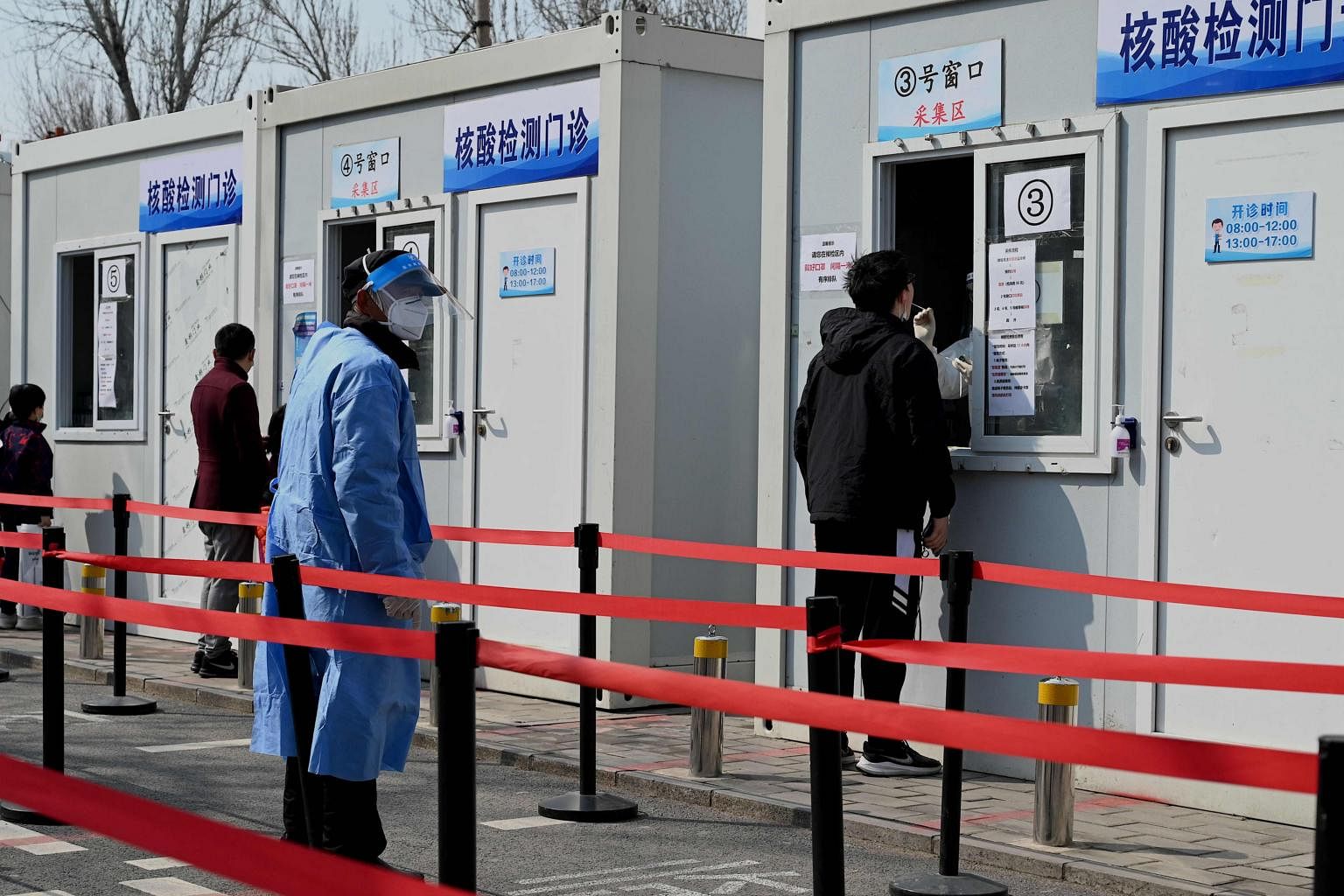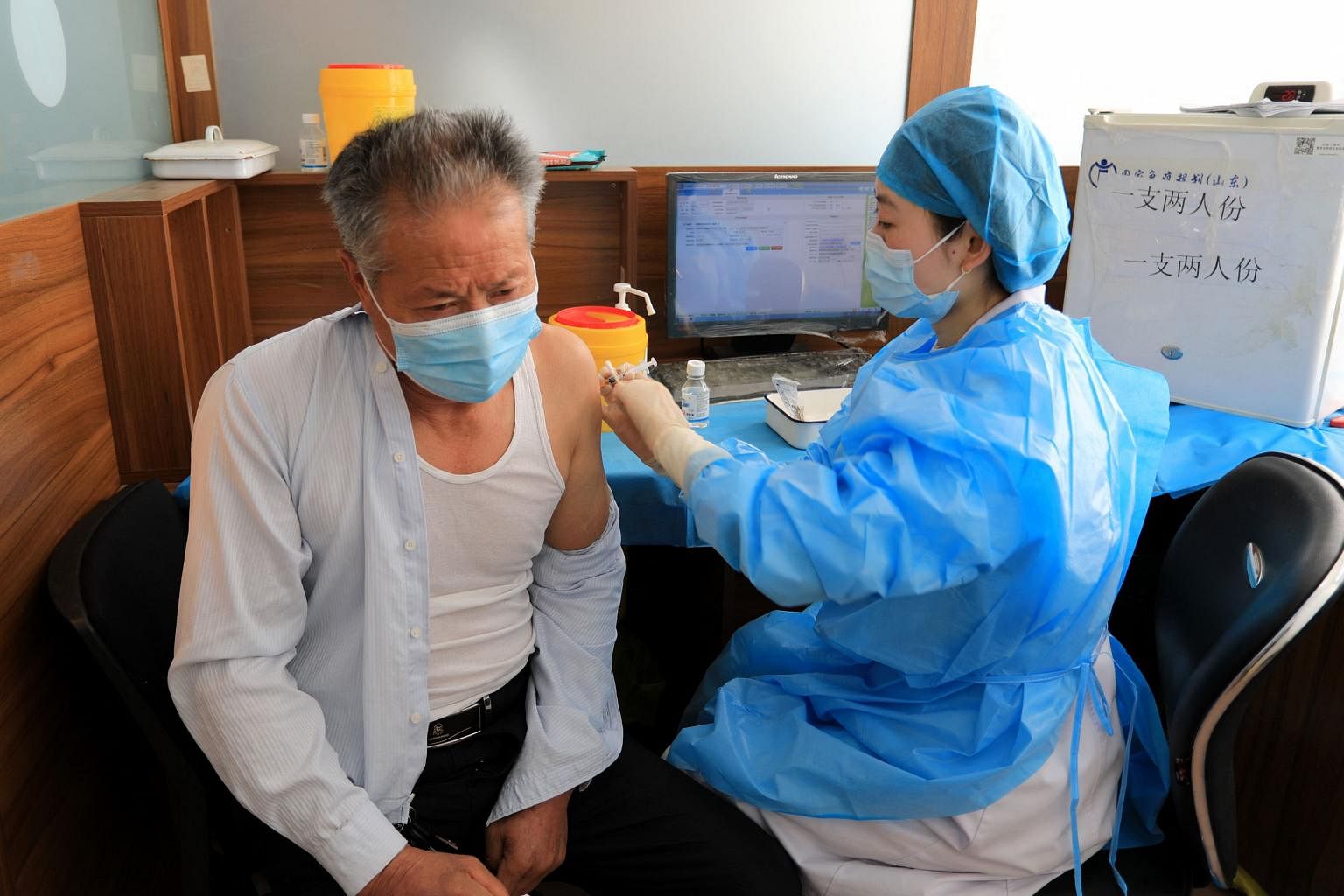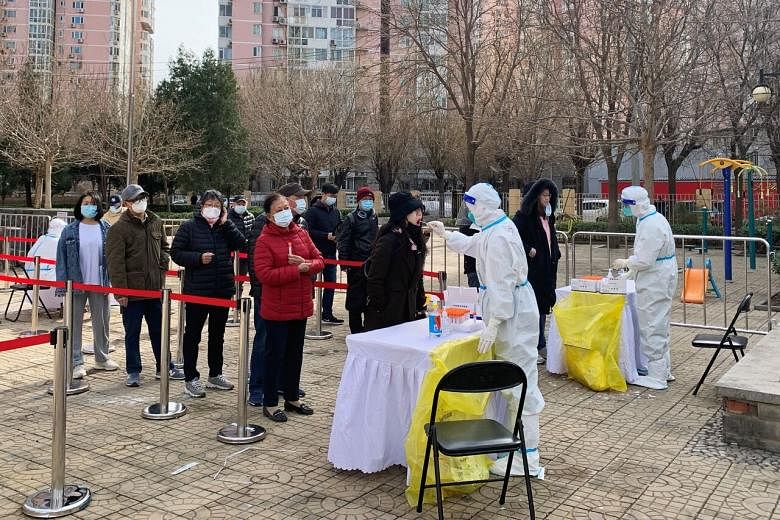BEIJING (CAIXIN GLOBAL) - As China's zero-tolerance approach to Covid-19 faces its stiffest test in the two-year-old pandemic, policymakers are moving to recalibrate the strategy to better protect the world's largest population while balancing the costs.
The nationwide daily case count soared sharply since the beginning of March as the highly transmissible omicron variant surged across China. New infections exceeded 5,000 March 14, the highest since the pandemic erupted in Wuhan in late 2019. As of March 17, 25,000 Covid cases were logged in the current upsurge.
From the small border city of Huichun in northeast Jilin province to southern metropolis Shenzhen to Shanghai on the central coast, clusters of infections have flared up, prompting local authorities to reimpose drastic virus controls such as mobility restrictions and community lockdowns.
The resurgence, mainly caused by the stealthy BA.2 subvariant of omicron, is posing fresh tests for China's two-year-old dynamic Zero-Covid toolbox of massive testing, rapid contact tracing and strict quarantines as the virus becomes increasingly hard to track because of its milder symptoms. The BA.2 subvariant has dominated outbreaks in many parts of the world that are experiencing rebounds of Covid-19.
While many countries have been trying to coexist with the virus, Chinese officials have vowed to stick with its Zero-Covid strategy to bring the pandemic under control as soon as possible, reflecting China's huge population and under-resourced hospital system.
"Given the size of China's population, even the low fatality rates reported overseas could mean millions of deaths," said a former official of the National Health Commission (NHC). The country's virus control strategy must be redoubled on the basis of scientific evidence, the official said.
Regulators have moved to fine-tune policies to make the virus control strategy better fit the new normality. The NHC last week revised its Covid-19 response protocol with major changes to diagnostic criteria, treatments and quarantine requirements. The revision, the ninth since the pandemic started, was made to address rising omicron outbreaks and indicates a step toward more-relaxed virus controls, experts said.
At a meeting Thursday (March 17), President Xi Jinping called for improved measures to maximize effectiveness in controlling the outbreak at the lowest cost while minimizing the impact on economic and social development. In the third year of the pandemic, it is time for China to calibrate and set forth future plans to combat the virus with greater precision, experts said.
"What we need most at the moment is epidemiological risk assessment," said Wang Guangfa, director of the Department of Respiratory and Critical Care Medicine at Peking University First Hospital. "Under different strategies, how many patients will there be?" Wang said. "How quickly can the patients be discharged? Can the medical system bear it? With a comprehensive evaluation, we can have a clearer idea for the next step."
Rebounding outbreaks
Despite sporadic flare-ups, China has kept the coronavirus at bay since 2020. But this resurgence looks different. On Friday, two Covid-19 deaths were reported in Jilin, the first fatalities in more than a year.
The northeast rustbelt province is one of the worst-hit areas in the outbreak. Since the first positive case was detected Feb 28 in Huichun, the virus has spread throughout the province and beyond. As of March 17, Jilin recorded 14,000 infections among its 24 million residents, more than half of the nationwide tally in the latest outbreak.
A thousand kilometers away from Jilin, Laixi city in Shandong province on the eastern coast detected a new infection March 4 in a middle school. Although restrictions were soon deployed, the virus quickly spread among students and communities. In 10 days since the first cases, 692 infections were confirmed in the city.
Around the same time, a resurgence escalated in Shanghai, China's largest city and a global financial hub, after the virus sneaked out of a hotel designated for inbound travelers in quarantine. Further to the south, the technology center Shenzhen also had a spike of cases in early March after weeks of tough battles to keep the virus from seeping across the border with Hong Kong, which has been fighting its worst outbreak since February.
In less than three weeks since March 1, 27 of China's 31 provinces have reported new flare-ups. The case tally reached 25,420 March 17, nearly 30 per cent of the number of cases reported by the end of 2020 after the pandemic broke out in Wuhan.
The latest infection spike in China has mainly been driven by the BA.2 and BA.1.1 subvariants of omicron. Both are known for high infectiousness, said Wu Zunyou, chief epidemiologist at the Chinese Center for Disease Control and Prevention (China CDC). The variants have also caused major Covid rebounds in Japan, South Korea, Singapore, Vietnam and other countries.
The omicron variant first breached China's tightly guarded border in early January and caused mild local outbreaks in Tianjin and Henan that were quelled in about a month. But the new subvariant BA.2 is even more difficult to track than the most common omicron BA.1 lineage.
The BA.2 subvariant is more transmissible than the original omicron strain, several epidemiologists said. It can drive case counts to double within three days while causing milder symptoms that are hard to detect. It means that by the time the first case is uncovered, the virus has already spread among communities for days, they said.
A major challenge in controlling the omicron variant is its stealthy nature and relatively short course of disease, which make it difficult to detect early infections through nucleic acid tests and to trace transmission, said Jin Dongyan, a biochemistry professor at Hong Kong University.
Strategy adjustments
On March 15, the NHC made major revisions to its Covid-19 diagnosis and treatment guidelines to address the new features of omicron infections. The updated guidelines revised criteria for infected patients to be hospitalized, allowing those with mild symptoms to be placed in centralized quarantine sites instead of designated hospitals.
The change reflects the fact that most omicron-infected patients don't require medical intervention. It will allow hospitals to focus resources on patients in need, experts said. In addition, the new guidelines lower the hospital discharge criteria for negative Covid-19 nucleic acid tests of recovered patients and shortens their required quarantine period, changes that will allow recovered patients to return sooner to normal life.
The NHC also added antigen tests as a supplement virus vetting method. That followed the first-time approval March 10 for rapid antigen tests to be put into public use in China. Jilin province purchased 12 million antigen test kits March 14 for rapid Covid-19 testing and started distributing them to residents.
While widely used in other parts of the world, rapid tests were restricted in China, where more accurate nucleic acid tests were the recognized method for diagnosing Covid-19. But in the face of the rapid flare-ups of the omicron variants, more-rapid and easier testing methods are needed to help detect and stem outbreaks more quickly, especially among asymptomatic carriers, said Jiao Yahui, an official at the NHC.

One remaining question is whether the production capacity of antigen test kits can catch up with demand. China is home to many Covid-19 test kit producers, but most of them have focused on exports in the absence of domestic approval for public use. As a result, most kits on the market are produced to foreign standards and haven't received approval from domestic medical regulators.
As of March 16, China's National Medical Products Administration (NMPA) approved 12 antigen testing products for Covid-19. Meanwhile, many of the more than 100 test kit producers in China have submitted applications for a review of their products.
She Tao, marketing director of Beijing Wantai Biological Pharmacy Enterprise, said the company spent nearly four months winning approval for its antigen test kits. "The review was strict," She said. Many producers may need to renovate their production facilities to meet regulatory standards, the executive said.
In addition to the new testing method, China listed Pfizer's new Covid-19 pill, Paxlovid, among official treatments. It was the first such recommendation since the NMPA issued conditional approval of the treatment Feb 11.
A monoclonal neutralizing antibody therapy developed by Chinese company Brii Biosciences was also included as a recommended treatment. Neither treatment has yet been put into clinical use on the mainland, Caixin learned. China Meheco Corp. in early March said it signed an agreement with Pfizer to bring Paxlovid to the mainland. Details of the sales arrangement remain unclear.
Brii's antibody therapy is under review for process performance qualification before it can be commercialized, according to Chief Financial Officer Li Ankang, who said he expected the review to be completed in April. Compared with antibody therapy, antiviral pills like Paxlovid and Merck & Co.'s Molnupiravir are more likely to be the mainstream Covid-19 treatments due to their affordability, experts said.
Several Chinese drugmakers are also working on their own pills for Covid-19. Ascletis Pharma and Shanghai Junshi Biosciences are the farthest along. Both companies are waiting to complete required clinical trials and regulatory approvals. Ascletis Chairman Wu Jingzi disclosed that the company's pill, known as ASC10, will cost US$50 (S$67.80) for each cycle of treatment in government procurement, compared with US$530 for Paxlovid.
Optimizing vaccination strategies
China is also trying to find the optimal strategies for vaccination. In February, regulators approved the mixing of domestic vaccines as boosters to improve immunity.
The country has so far approved seven domestically developed vaccines including five inactivated virus vaccines, one viral vector vaccine and one based on recombinant protein technology. Real-world statistics on the vaccines' effectiveness against omicron have yet to become available.
But various clinical studies have suggested that the mixed use of vaccines with different technologies will trigger stronger immune responses. Currently available vaccines in China have a good effect on preventing severe illness, but to further reduce the probability of breakthrough infections, more types of vaccines with better efficacy are still needed, said Lin Jinzhong, a professor at the School of Life Sciences of Fudan University.
Currently two mRNA Covid-19 vaccines - one developed by Pfizer and BioNTech and another by Moderna - are in use globally. Those vaccines outperformed others in clinical trials and are by far the most-administered Covid-19 shots in the world. The Chinese mainland hasn't yet approved any mRNA vaccine for public use.
Research on several home-grown Covid-19 vaccines using mRNA technology are underway. One of the frontrunners, known as ARCoV being developed by Walvax Biotechnology and partners, is in clinical trials overseas.

But Fudan University's Lin said it may still take time for China's home-grown mRNA vaccines to become available due to time-consuming research and limited access to key raw materials. As of March 14, 88 per cent of China's 1.4 billion population, or 1.24 billion, were fully vaccinated, according to official data. But only 44.7 per cent of the population received a booster shot for enhanced protection.
Meanwhile, only half of Chinese people who are 80 or older are fully vaccinated, highlighting a key vulnerability as Covid-19 can be much deadlier among the elderly. Of the 264 million Chinese who are older than 60, 52 million have yet to be fully vaccinated, official data showed.
It is pressing for China to regularly investigate and report the immune response and antibody levels among the vaccinated population, said Zhao Dahai, executive director of the Shanghai Jiaotong University-Yale University Joint Center for Health Policy. In particular, large samples of real-world data are needed to compare people of different ages and regions under different vaccination options to further improve vaccination policy, Zhao said.
At the end of this year's national legislative meetings, Premier Li Keqiang said China intends to make its Covid control measures more scientific and precise while it works to ensure the orderly and smooth flow of goods and people. The premier's comment was seen as a clear signal that the country is moving toward reopening.
The characteristics of omicron infections and China's demand for international communication determined that the epidemic prevention strategy should be adapted to actual needs and take into consideration the economic and social costs, said Xue Di, a public health professor at Fudan University.
This story was originally published by Caixin Global.











